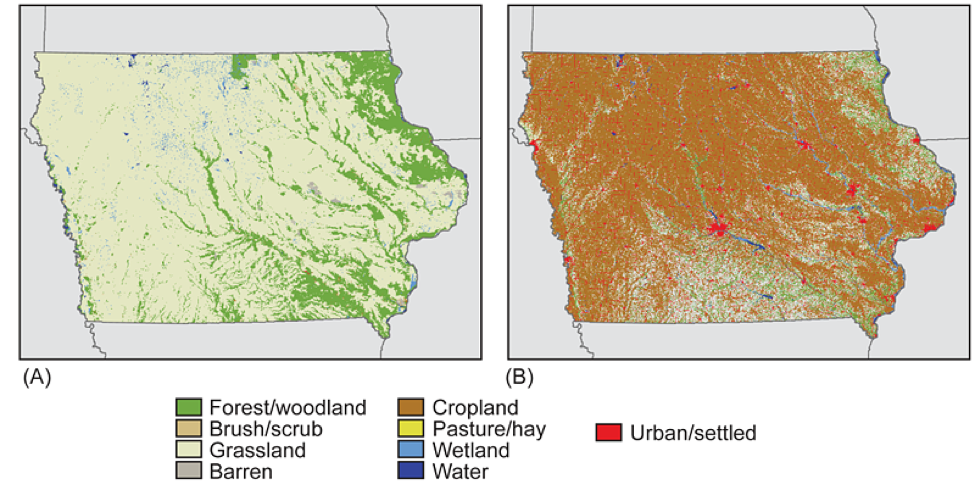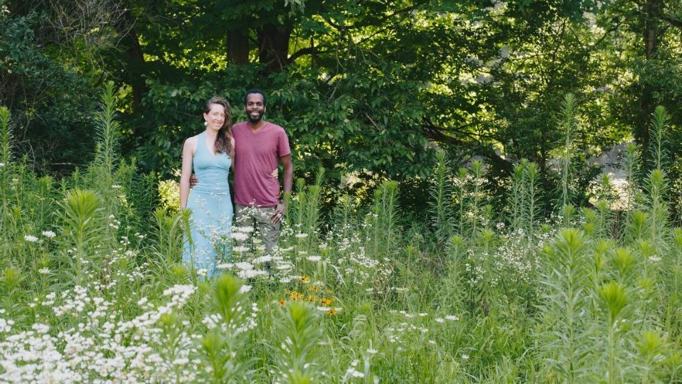Bundle 5: Iowa’s Changing Land Use
Tier 2: Iowa’s Natural Resources and Ecosystems
Tier 2: Iowa’s Natural Resources and Ecosystems
Objective:
Students will develop skills and knowledge regarding some of Iowa’s natural resources and/or ecosystems. By researching a local landscape (ideally by traveling there, taking field observations, and interacting with knowledgeable guides, educators, or caretakers), students will learn about how the landscape and its relationship to humans has changed over time. If available, we recommend a nature preserve, natural area, or native landscape for this Tier 2 lesson. Using the data and observations recorded, students will make inferences about the landscape.
Overview:
This series of investigations is meant to expose students to the examination of Iowa’s natural resources and ecosystems. Areas of focus can be the interactions of landscape with climate, water cycle, habitat (for mammals, amphibians, birds, fish, insects, etc.), or agriculuture. Students will be introduced to natural resources as they examine how biotic and abiotic factors work together to sustain each other in a natural environment. Student investigation of native, preserved, or natural landscapes can serve as a useful reference point when considering human landscape alteration.
Big questions:
- What was Iowa like when European settlers first arrived?
- What lived here before modern agriculture was established?
- How did the ecosystem in my local area look and work together?
Standards addressed:
| MS-ESS3-3 |
Apply scientific principles to design a method for monitoring and minimizing a human impact on the environment. |
| MS-ESS3-4 |
Construct an argument supported by evidence for how increases in human population and per-capita consumption of natural resources impact Earth’s systems. |
| MS-LS2-5 |
Evaluate competing design solutions for maintaining biodiversity and ecosystem services. |
| MS-ESS2-4 |
Develop a model to describe the cycling of water through Earth’s systems driven by energy from the sun and the force of gravity. |
| Science and Engineering | |
| Crosscutting Concepts |
Tier in depth:
Option 1: What’s the Story of _______?
*These represent sample questions that this investigation can address. Students should formulate their own research question as they acquaint themselves with a natural landscape:
-
What was Iowa like when European settlers first arrived?
-
What lived here before modern agriculture was established?
-
How did the ecosystem in my local area look and work together?
Iowans have very little day-to-day exposure to their natural ecosystem. A majority of the state is now used for cropland; therefore, many Iowans have little knowledge of what a native tallgrass prairie, woodland, or wetland look like.
 Figure 1. Iowa land cover in the mid-1800s (A) and as of 2001 (B, mapped with data from the National Land Cover Database, https://www.mrlc.gov/). See Gallant et. al (2011).
Figure 1. Iowa land cover in the mid-1800s (A) and as of 2001 (B, mapped with data from the National Land Cover Database, https://www.mrlc.gov/). See Gallant et. al (2011).
As we consider the interaction between humans and our environment, it’s important to gain a reference point of our natural resources and tangibly experience them. Students will research a local preservation site in order to understand the ecosystem. They will take notes, pictures, and video to record their observations and make inferences about that native area. They will then compare them to expert claims and observations and determine if they have consensus. Then, synthesizing their observations, data, research, and claims, students will present to classmates, younger students, or in an interview to their teacher in a format of their choosing. Their goal will be to tell the story of that natural site and how living and nonliving factors interact with each other within the context of the student’s own research question. This is a good opportunity to encourage students to create videos, blogs, comic books, maps, posters, essays, or scientific journals.
Resources to Natural Preservation Sites and Introductory data on the ecology of those areas:
http://www.iowadnr.gov/Places-to-Go/State-Preserves
http://www.inhf.org/resources/publications/
*Special resource for Johnson County: https://www.buroaklandtrust.org
Note: Bur Oak Land Trust is an example of a land conservation group specific to Johnson County and her bordering counties. Other organizations like it exist in many counties across the state.
______________________________________________________________________
Option 2: Prairie Grass Modeling: How is Prairie Grass different from the grass in our lawns? Should you grow a prairie in your lawn?
*These represent sample questions that this investigation can address. Students should formulate their own research question as they acquaint themselves with a natural landscape:
-
What makes prairie grass so different from grass we grow in our yards?
-
How does the difference in root structure affect water absorption?
-
How can individuals preserve natural ecosystems?
-
What is the benefits of preserving natural ecosystems regarding rainfall, and soil absorption?
This option includes a comparison of prairie grass and lawn grass. There are several social phenomena attached to this investigation that might get the ball rolling for students.
Story Introduction 1: The story of a woman published in a Chicago Tribune story in 2015 who has been in conflict over city ordinances for years over her pollinator friendly yard in Ohio:
Sarah Baker and her partner in Alexandria, Ohio: When I stopped mowing my lawn, a diverse potpourri of plants began to flourish, and a rich assortment of insects and animals followed.
 (Courtesy of Sarah Baker) 1000×563
(Courtesy of Sarah Baker) 1000×563
Story Introduction 2: For students with a higher reading level or who show an interest in anthropology, Michael Pollen explores the American social concept of a lawn in his 1989 article originally published in the New York Times:
http://michaelpollan.com/articles-archive/why-mow-the-case-against-lawns/
Procedure: Students find two different slopes with equal gradient. One slope is covered with native prairie grass (perhaps at the same site their classmates are already studying in the “What’s the Story of____?” investigation), one slope is covered in yard grass (probably Kentucky Blue). APVC trough with a collection bucket is constructed and students dump water or set a sprinkler in motion at the top of the slope to determine which type of grass aids in water absorption better. Students determine what factors they will need to control in order to produce a good experiment. They should be encouraged to design and discuss their design with one another and other students outside their group. Students are also encouraged to modify their experiment to test for other factors. Students can synthesize their findings to make claims about modern yards and the costs and benefits of them, or to make inferences about how prairie grass is or is not well adapted to weather patterns and overall climate in Iowa. As students continue to ask questions they are encouraged to repeat and modify their experiment and compare their findings with expert regional and local research. Students are encouraged to choose a method of presenting their findings to a given audience. Students could write letters to lawmakers, develop a pros and cons list, write a story, do a demonstration, create a presentation, or be interviewed by their teacher.
Potential Offshoot questions for Tier 3 projects/investigations:
-
Explore preservation and restoration projects in Iowa and their local communities
-
Compare runoff in prairie grass, yard grass, and crops (with and without cover crops)
-
Compare runoff of grasses and crops to concrete
-
Explore the placement of rain gardens in cities and neighborhoods
-
Exploration of prairie grass responses to fires and drought
_______________________________________________________________________
Extra Resources:
Students who are curious as to the process of starting their own prairie garden can look here: https://www.extension.umn.edu/garden/yard-garden/landscaping/establishing-and-maintaining-a-prairie-garden/
Students who would like a guide for local Iowa grasses can look here: http://www.eeob.iastate.edu/research/IowaGrasses/
Sources:
Gallant, A. L., Sadinski, W., Roth, M. F., & Rewa, C. A. (2011). Journal of Soil and Water Conservation.
Experts:
Solutions:

